I'm so excited for this one!
The Score! is a game I've never heard of, by an author I've never heard of. It's the usual story of browsing the Museum to find something interesting and getting it. And I almost didn't. While first browsing, I was curious about the author's second game Adventures with Neesboy a title that always stuck out to me every time I came across it.
After having mistakenly played the older version of Total Chaos only to discover afterwards that there was an ever so slightly cleaned up revision I could have played instead, I made sure to check the author's other releases before even starting, only to discover The Score!, Orange698's first and only other ZZT release.
Both games appeared to be massive. Each well over eighty boards and a good 280 kilobytes in size. Considering that I knew nothing about the author and that these two huge worlds were released six months apart, I opted to play a bit of The Score! and see if it might be more interesting to tackle as my own introduction to Orange's work.
As far as subject matter for Closer Looks go, I struck gold. A rich vein to boot. An unusual premise of striking it rich by becoming a "Cargo boy" led me on a lengthy delve into one of the most unique ZZT games I've come across. This game is full of surprises, showing some real incredible work for presumably the author's first ZZT game. It was an epic journey that took me more than three hours to complete as I traveled a world full of distinct cities, loaded with oddball characters, crammed full of secrets, and making heavy use of an invisible timer as a form of randomization.
My partner, who had been home while I played the majority of it asked me if it was any good.
"This game is absolute torture", I replied.

Become A Cargo Boy
How could it be, that this game could do so much to amaze, and yet be so aggravating to play? Well. It's a slow descent into madness. We can worry about the specific problems the game has later on, for now let's focus on the many positives.
Pay attention though, and you'll be able to predict where things go horribly wrong easily enough. Then we can discuss the troubles that you won't know about until they're suddenly revealed.

The game's core premise is simple enough that its revealed in the first popup that appears upon starting the game. Start from nothing, and become rich.
In The Score, you play as a nameless child of unspecified age. A boy likely somewhere between ten and thirteen. Too young to get a part-time job as a golf caddy, little league concession stand worker, or suckered into the world of fast food, but old enough to want more cash than a weekly allowance could pay.
What he can do, is sign up to become a cargo boy. This institution is an honored one in this world, with many adults having spent their youth working as members. Cargo boys are kids who in real life would be suckered into things like selling seeds in exchange for prizes or in the case of my childhood, trying to sell the most chocolate candies in hopes of winning a mountain bike or Game Gear. (Surely I wasn't the only one?)
Listen, it was better than vidalia onions, that's for sure.
For kids in this world though, the dream is very much a reality. All it takes to become rich is patience, persistence, and being able to recognize a good deal when you see one. Everyone is so on board for this kind of entrepreneurship that there isn't even a cut being paid out to the organization. You buy what you what, you sell what you want, and whatever you take in is yours to keep. With nothing more than an empty bag and a few dollars worth of score (generously donated by the organization), the cargo boy begins his adventure of buying low, traveling to a neighboring city, and selling high.
Each year a new crop of boys (and girls) join the ranks, sell as much as they can, and hope to become rich. There's truly no downside here. No threat of outstanding debts to keep your on your toes. Simply enjoy the great outdoors and start selling!
Terms and conditions apply.
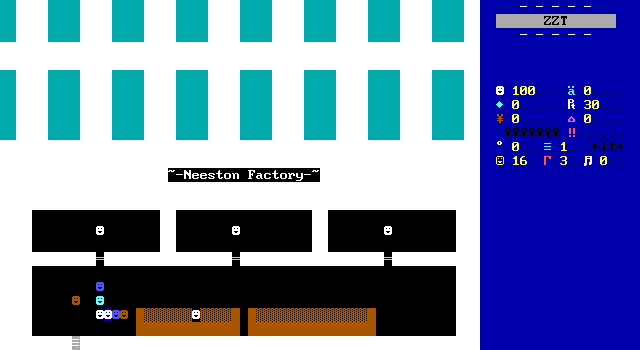
Cargo boys are most heavily limited by their bag. Despite the abundance of clever ideas found within The Score!, only one bag upgrade is ever received, which only allows you to carry different items rather than larger quantities.
In practice, you'll have at most fifteen items stored in your bag at any given time. Orange pulls out all the stops for a first game and uses flag juggling to track inventory with only one flag per product. This makes the limitation a somewhat arbitrary one (ZZT's flag parsing might make it a pain to easily track double digits), but the entire game is designed around the limited bag space, with some concessions to avoid awkward moments of being unable to take rewards due a packed inventory.
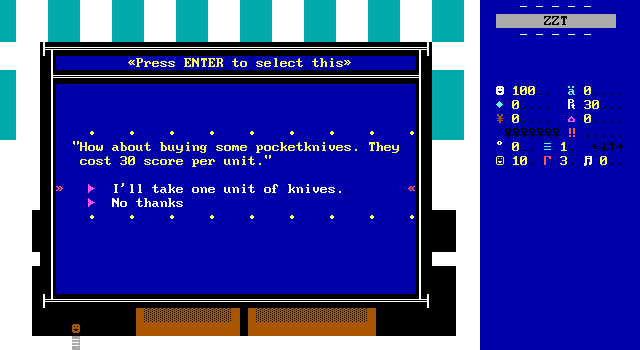
You can't just buy anything you want though. Perhaps this is where the organization is getting their cut. The items available for cargo boys to purchase for sales purposes is limited to a few select products each year. One assumes the the "factory prices" include a few score for the higher ups. More practically speaking, the cargo boy will find himself limited by his nearly empty pockets.
Money, especially in the beginning is a major limiting factor as you'd expect from a trading game. Initial trips will send the boy off with a half-empty bag, making only the slimmest of profits on a good day. As your earnings increase, a big full of goods is transformed into a sack of cash, or Score as the game dutifully calls it, wisely divorcing itself on any meaningful way to compare the cost of items in game to that of the real world.
As the cargo boys for the year earn money, they can receive promotions for crossing certain thresholds. These goals are all measured by score on hand, so the moment you cross a line, it's in your best interest to apply for a promotion. As you level up, you're given access to new cities and nicer products to push on consumers with an insatiable thirst for toys, tools, and electronics.
Being promoted to a level two cargo boy feels like the biggest hurdle of all. This initial target is 3,000 score, something that in the endgame can be amassed in a single loop of buying and selling. In the beginning, it seems like an impossible amount of money, a goal that ought as well be a million dollars to a child. The requirement for cash that seems so far away leads to stingy penny-pinching to make every last point count. Cargo boys need to hoard their cash as much as possible. This can be accomplished with nothing short of a grind mindset. Minimize time spent resting in hotels. Avoid spending cash on frivolous pleasures like soda. Travel by walking the roads rather than paying for public transit. These are sacrifices that have to be made if you ever want to see level two.
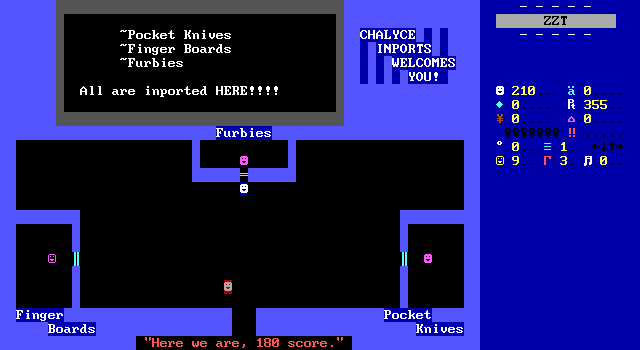
Reaching the second level opens up bigger opportunities, maintaining the same buying and selling structure from before, only now with items that make considerable profit. Not only are more valuable items available, but rather than buying them at factory prices, they're themselves bought from the market. Fluctuating prices that before were only factor when selling, now become an essential component to buying. Cargo boys are encouraged to pay close attention to pricing to get the best deals on both ends of the supply line, maximizing profits to a degree that was unthinkable at level one. The next goal is 10,000 score. This time, it feels like it's reach right from the start.

Getting promoted from level two to level three is considered a rarity in the world of cargo boys. Few have what it takes to make the grueling trips between cities, but once you can sell items for hundreds of score in pure profit, you can afford to live a little. Instead of dealing with hazards out on the roads, falling into mud, or being caught up in target practice, esteemed cargo boys can relax, no longer to worry about how they'll afford their next haul of cargo if they buy a subway ticket home. Soda, comfy hotel beds, and even some mini games for your amusement are now trivial. At worst, just distractions from your duties and dream of advancing to the next level.
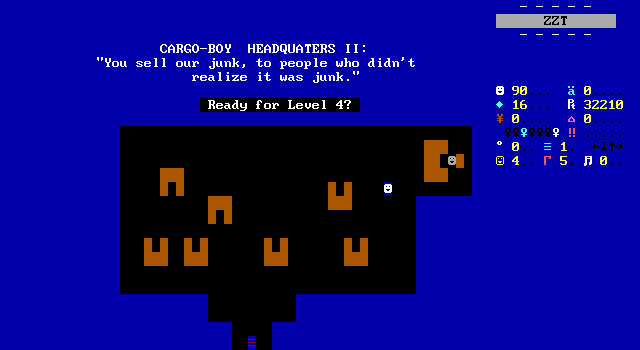
If you still want more, you can press on to become a level four cargo boy. This final rank is the logical goal for the game, requiring 30,000 score to become eligible. A cargo boy organization employee makes it sound like reaching this level is almost mythical. At this point, the entire world is open to be explored, a necessity as while the the game ends with the promotion to level four, Orange698 isn't about to make the finale as simple as increasing a number yet again.
The Merch
The items for sale really mark when the game was made. They're also mostly things I wouldn't trust a child to sell. The amount of responsibility given to anyone that can hold a bag is really something else. There's quite a vibe that this is a world that revolves around the cargo boy lifestyle. It's the only way it could work as well as it does in game.
At the onset of the game, the Neeston factory is the sole source of goods. Players have three items available to them, and they can't really be picky as only five of each item can be held onto at once. The fuller the bag, the better the profit. You'll just have to be sure that after selling your goods you leave enough set aside to purchase inventory for the next haul.
Pocket Knives - Let this child with a bag full of knives onto the subway please. There's money to made. Maybe seen as a bit inappropriate to let kids buy and sell these days, but as the twentieth century gave way to the twenty-first, knives were cool. If a child tried selling me a knife, I'd assume I was in some sort of sting operation. Otherwise, at least the item is practical enough.
Finger Boards - A true symbol of the new millennium. Finger boards may be the generic term, but I feel like everyone just called them Tech Decks. These feel like the perfect toy to be sold to children in bulk that then have to try to sell them to neighborhood kids. Good luck if they aren't the name-brand. Tiny punks demand names like Zero, Birdhouse, and Zoo York. Today, if a child tried selling me a tiny skateboard, I'd have a hard time not saying no. It would give me a good answer for "What did you get up to today?"
Furbies - If a kid had a bag full of these it would be stolen in minutes. In the early game, Furbies are the closest thing to a luxury good, and it's very funny to imagine a kid hauling them across town. I would not buy a Furby from anyone of any age. They were always a bit uncanny to me.
PCs and Macs - Once a cargo boy reaches level two, they gain access to an import shop which sells electronics. Their bags are unable to hold the game's final item so runs wind up being smaller for awhile. Again, funny to imagine a kid hauling ten computer towers. (five in beige and five colorful Macs I'm sure.) Orange698 usually just writes MAC, and has a habit of writing "Macontosh" by mistake when listing the proper name. While I would love to buy a nice Pentium 3 PC from a child, it would be difficult to justify a second one in the home.
Rather annoyingly, in order to prevent the game from running out of flags, the game restricts players from having both Macs and Furbies in their bag. This does slow things down as you can't do the obvious strategy of making a small detour to buy Furbies while waiting to be able to purchase the game's final major item.
Big Screen TVs - I don't know how well a bigger bag is going to help a kid lug five CRT televisions several miles down the road, but it does. In the year 2000, this makes grinding out the final level a matter of walking around with an entire Circuit City store's inventory in your bag.
ZZT Stuff - While everything else is limited to holding five at most, cargo boys can also wheel and deal in ammo, torches, and gems. These items can't be purchased directly, and instead are used as rewards for mini-games or as rewards for finding hidden areas. It's a brilliant idea that avoids the awkwardness of finding a secret and being unable to collect anything until you sell your current goods and come back again.
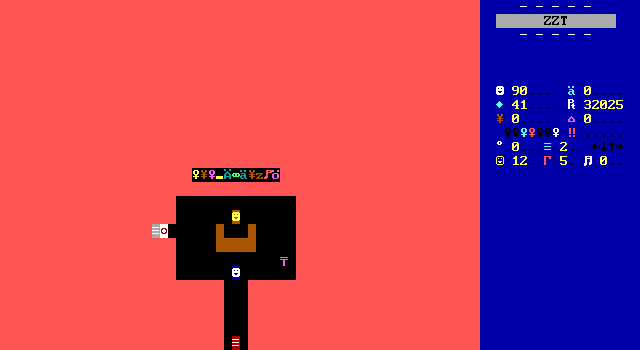
ZZT's items also play by different rules for selling. You need to find an actually interested party, some of whom will be repeat buyers while others will only need some item once. Prices and availability vary, with some NPCs disappearing past certain points in the game. Technically you can hoard these items until you find whoever the best buyer in the game is, though the score acquired for selling is more of a small bonus, making these items more of a perk to justify taking the subway rather than a major part of your sales.
Geography
Orange698 did a fantastic job with their urban architecture. This is a game where 90% of the action is traveling from point to point. Orange populates the world with a number of unique towns that each have their own unique identity to them. While you'll find the usual staple locations everywhere, there's a lot of variety that makes exploring each city completely engaging in a way that's rather uncommon in ZZT. The world feels incredibly diverse in the people you meet in town and the personalities of those that call each place home. It starts with the run-down industrial town of Neeston with trips to the quiet small town of Chaylice for your first journey into the world. Then to Imaginapopilis, a flashy city focused on culture, before heading to the near-futuristic feeling Timelapse City. Oh, and don't forget the little fishing village, so far out of the way that they don't even have an import center to sell goods at.
Entering a new city for the first time is undoubtedly the highlight of the game. There's genuine excitement of what you'll find, who you'll meet, and what it will look like. Though the promotions are the real chapter breaks on your sales journey, it's the discovery of a new town that makes you feel like progress has been made.
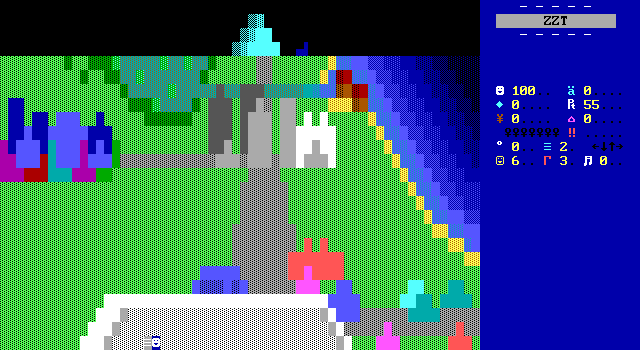
Two moments really demonstrate Orange's abilities here. The first is found in Chalyce, where the top floor of the town hall gives players an excellent view of the game's entire world. I found myself very much surprised at how much was captured in its simplicity.
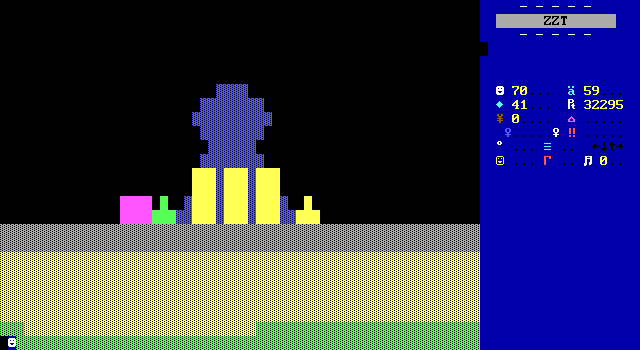
The second was during the game's credits sequence. This ending sequence lovingly shows off a number of the games cast, accompanied by shots of each city. All of which happen on a single board. Some great work with invisible walls is done here to make buildings appear, disappear, and become parts of larger structures as the game covers each location in a way that recognizable without the need to tell players what city they're looking at.
To be able to recognize multiple towns from new angles effortlessly is something Orange698 should be proud of. ZZT has hundreds of cities to explore, but I don't know how many of them I could identify being redrawn entirely out of solid walls.
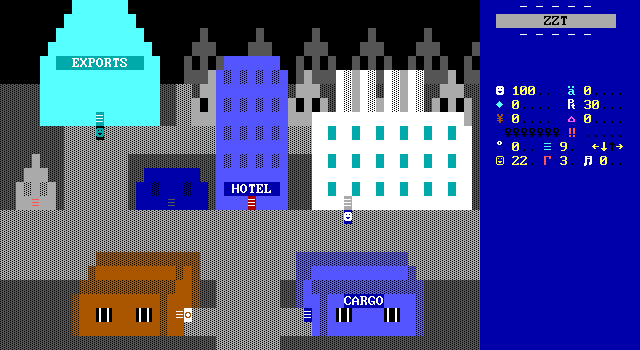
Players begin in the middle of the starting town of Neeston. A drab looking city filled with run down homes, heavy industry, abandoned buildings, and the Cargo Boys headquarters, where new recruits begin their journeys.
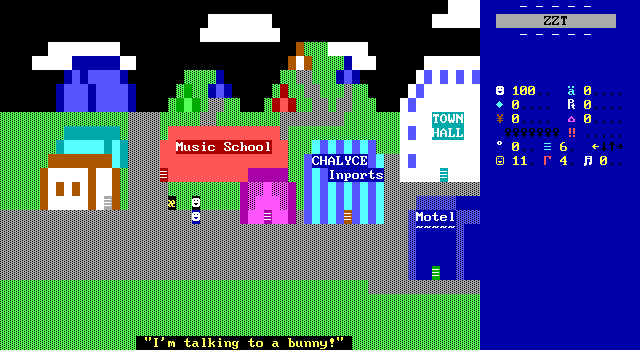
The first place to sell for an inexperienced cargo boy is to the east in the aforementioned town of Chalyce. This town introduces players not just to selling things at the local import store, but to the various side-quests available as well.
The town's unique features consist of a music school, a locksmith, and a town hall. These locations serve as introductions to the idea that you won't simply go from the factory to the export store to dump your merch. You'll be playing games, finding customers, exploring buildings of unknown purpose, and finding out that there are things to buy for yourself.
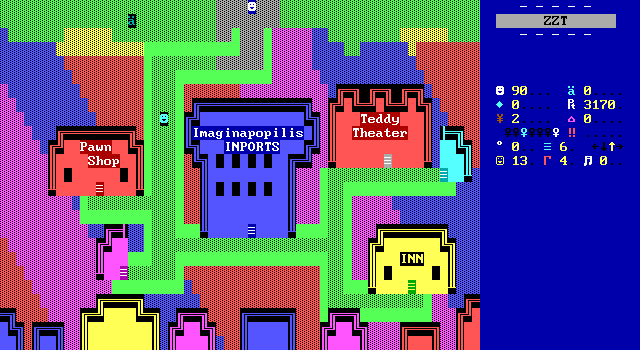
Once level two is reached, cargo boys are then trusted to travel south to Imaginapopilis. It's much larger than the quiet town that came before it, boasting significantly taller buildings. Players will only get to explore the cultural district with a theater and museum.
It does have one critical flaw that I'd rather mention now. The entire town is flashing rapidly? It's extremely unpleasant to look at, and definitely necessitates a warning for flashing imagery if you're going to play the game yourself. There's no explanation for it either! It just does that. It was so annoying that I tunneled my way via cheats to the location of the object responsible just so I could ?ZAP it.
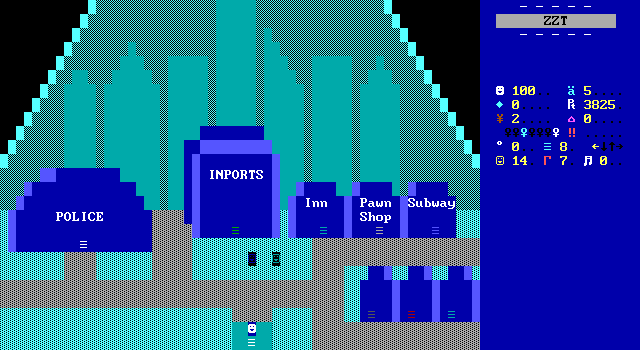
Upon reaching the third level, players can head to the game's final city with the excellent name of "Timelapse City". It's a futuristic place, contained within a giant glass pyramid. It's also a town full of rich snobs that look down on lowly cargo boys from "dirty" towns like Neeston. It doesn't have much to offer beyond the essentials. There's a police department here, because of course this is the town that would have a massive amount of real estate set aside for them.
Every town in the game hints at there being more than what players get to see. Chaylice has small homes built on hills in the background, Imaginapopolis has the tips of skyscrapers in the foreground along the bottom of the screen, and Timelapse has this real nice looking series of skyscrapers tinted by the pyramid. They do a wonderful job of feeling large without forcing players to wander down streets to find every possible building they can enter. Everything relevant is pushed front and center, while anything not, is purely decorative. Uh, except the science museum which is found next to the main city, likely because it attracts tourists who are outsiders to the good clean people of Timelapse.
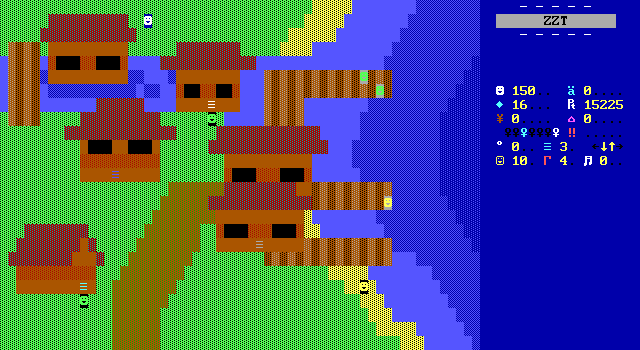
Lastly, there's an almost hidden fifth town simply known as "The Docks". Formerly associated with Neeston, the arrival of factories meant that bringing in good via sea was no longer necessary, and the region was left to do its own thing. This is mirrored in what you'll find there as well. There are no hotels or shops. Instead, a few buildings that contain a shooting gallery mini game and a rather unusual mini game where players need to avoid lions and find invisible torches.
The Docks are basically optional, and unlikely to be found until the route there from the back exit of the science museum is discovered well into the game. After a long walk through some fields and down a beach, players will discover the village and then how it actually connects to Neeston still, with an invisible passage connecting a road that looked like it was just disappearing into the background.


